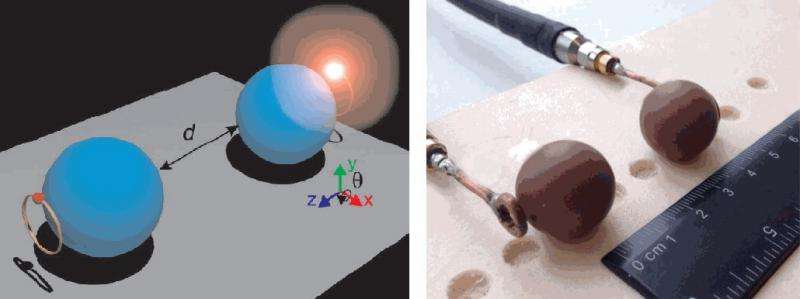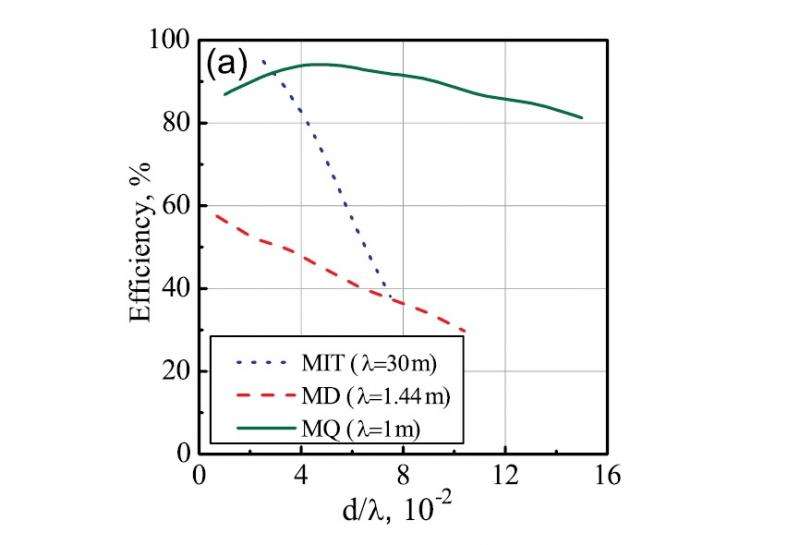January 26, 2016 feature
Scientists propose high-efficiency wireless power transfer system

(Phys.org)—Currently, commercial wireless power transfer is limited mainly to charging pads for phones: instead of plugging your phone directly into the wall, simply place it on top of a wireless charging pad. In the future, the same concept could be extended to much larger distances and higher transfer efficiencies, enabling entire rooms and even buildings to serve as wireless charging zones for phones, computers, and other electronic devices.
Although wireless power transfer (WPT) was famously pioneered by Tesla in the early 20th century, it was not until 2007 that a team of scientists from MIT demonstrated the feasibility of WPT (or "WiTricity"), by powering a 60-watt light bulb from a distance of two meters at 45% transfer efficiency.
Building on this work and others that have followed, a team of researchers led by Polina Kapitanova at ITMO University and Elizaveta Nenasheva at Giricond Research Institute, both in Saint Petersburg, Russia, have proposed a new WPT system. According to numerical simulations, their proposed system can maintain an 80% transfer efficiency across a distance of 20 centimeters, while experiencing only a very small decrease in the efficiency as the distance increases. Their work is published in a recent issue of Applied Physics Letters.
Like almost all WPT proposals, the new proposal is based on resonance coupling. Similar to how an opera singer's powerful voice can transfer enough energy to a wine glass having the same resonant frequency to cause the glass to shatter, a resonant copper coil can transfer energy to a second resonant copper coil if the two coils resonate at the same frequency. Other nearby objects are not affected because they do not have the same resonant frequency. In WPT systems, the resonant frequencies of the two coils are often coupled using magnetic fields to further reduce unintended interactions because magnetic fields interact very weakly with most other objects, including the human body.

In the new paper, the researchers demonstrated that they could decrease power loss—and therefore increase efficiency—in WPT systems in two ways. First, they replaced the traditional copper coils with "high-permittivity low-loss dielectric resonators," which look like two ceramic spheres. These resonators have a high refractive index, meaning that an electromagnetic wave traveling through them is greatly slowed down. For WPT, this property translates to stronger magnetic resonances in the ceramic spheres, and stronger resonances lead to higher efficiencies.
The second change the researchers made to decrease radiation loss was to use a higher-order resonant frequency mode than is normally used (they used the magnetic quadrupole mode instead of the magnetic dipole mode). These two frequency modes differ in terms of the shapes and magnitudes of their magnetic fields. The researchers found that the WPT efficiency of the system operating at quadrupole mode is not only more efficient, but also more resistant to the random orientation of the transmitter and receiver in space. As owners of wireless phone chargers know, the phone must be perfectly aligned on the pad to receive power. The quadrupole mode does not require such exact alignment.
"The main idea of this work is to demonstrate the near-field magnetic resonance WPT based on high refractive index dielectric resonators," Kapitanova told Phys.org. "In contrast to the traditional copper coils, the high refractive index dielectric resonators support higher order modes. So we propose to operate at the magnetic quadrupole mode rather than the magnetic dipole mode. This results in the higher WPT efficiency due to a reduction in the ohmic and radiation losses."
In the future, the researchers plan to further improve the WPT system by designing the receiver with better resistance to random orientation at all angles. They also plan to reduce the size of the resonators for practical use.
"Now we are working on fabrication and experimental investigation of the next WPT system prototype," Kapitanova said. "In cooperation with the Giricond Research Institute, we have fabricated new ceramic resonators with higher dielectric permittivity and low loss tangent. We believe this prototype will be very close to practical application."
More information: Mingzhao Song, et al. "Wireless power transfer based on magnetic quadrupole coupling in dielectric resonators." Applied Physics Letters. DOI: 10.1063/1.4939789
Journal information: Applied Physics Letters
© 2016 Phys.org




















